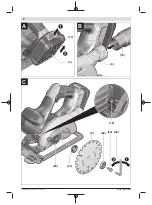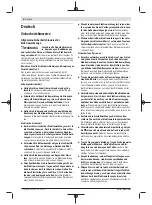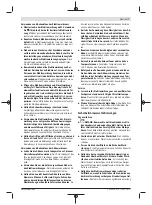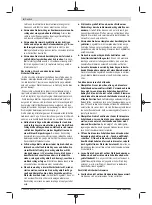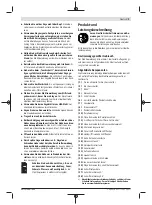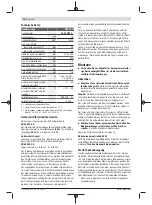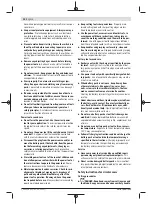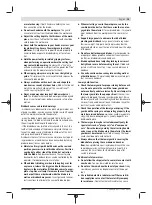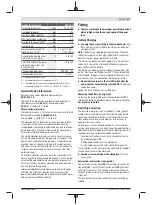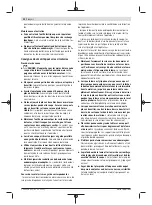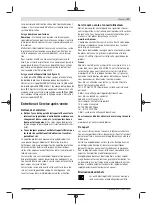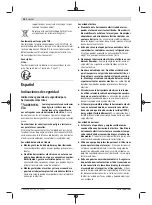
English |
17
Handheld circular saw
PKS 18 LI
Base plate dimensions
mm
133 x 244
Saw blade diameter
mm
150
Max. base blade thickness
mm
1.4
Max. tooth thickness/offset
mm
2.0
Min. tooth thickness/offset
mm
1.5
Locating bore
mm
16
Weight according to EPTA-
Procedure 01:2014
A)
kg
2.7 kg (1.5 Ah) –
3.1 kg (6 Ah)
Recommended ambient tem-
perature during charging
°C
0 to +35
Permitted ambient temperat-
ure during operation
B)
and
during storage
°C
-20 to +50
Recommended batteries
PBA 18V...W-.
Recommended chargers
C)
AL 18...
A) Depends on battery in use
B) Limited performance at temperatures <0 °C
C) The following chargers are not compatible with the PBA re-
chargeable battery: AL 1814 CV, AL 1820 CV, AL 1860 CV
Noise/vibration information
Noise emission values determined according to
EN 62841-2-5
.
Typically, the A-weighted noise level of the power tool is:
Sound pressure level
88
dB(A); sound power level
99
dB(A). Uncertainty K =
3
dB.
Wear hearing protection!
Vibration total values a
h
(triax vector sum) and uncertainty K
determined according to
EN 62841-2-5
:
Sawing wood: a
h
<
2,5
m/s
2
, K =
1,5
m/s
2
The vibration level and noise emission value given in these
instructions have been measured in accordance with a
standardised measuring procedure and may be used to com-
pare power tools. They may also be used for a preliminary
estimation of vibration and noise emissions.
The stated vibration level and noise emission value repres-
ent the main applications of the power tool. However, if the
power tool is used for other applications, with different ap-
plication tools or is poorly maintained, the vibration level
and noise emission value may differ. This may significantly
increase the vibration and noise emissions over the total
working period.
To estimate vibration and noise emissions accurately, the
times when the tool is switched off or when it is running but
not actually being used should also be taken into account.
This may significantly reduce vibration and noise emissions
over the total working period.
Implement additional safety measures to protect the oper-
ator from the effects of vibration, such as servicing the
power tool and application tools, keeping their hands warm,
and organising workflows correctly.
Fitting
u
Only use saw blades the maximum permitted speed of
which is higher than the no-load speed of the power
tool.
Battery Charging
u
Use only the chargers listed in the technical data.
Only
these chargers are matched to the lithium-ion battery of
your power tool.
Note:
The battery is supplied partially charged. To ensure
full battery capacity, fully charge the battery in the charger
before using your power tool for the first time.
The lithium-ion battery can be charged at any time without
reducing its service life. Interrupting the charging process
does not damage the battery.
The lithium-ion battery is protected against deep discharge
by the "Electronic Cell Protection (ECP)". When the battery
is discharged, the power tool is switched off by means of a
protective circuit: The application tool no longer rotates.
u
Do not continue to press the On/Off switch after the
power tool has automatically switched off.
The battery
can be damaged.
Follow the instructions on correct disposal.
Removing the battery (see figure A)
To remove the battery
(3)
, press the release button
(17)
and pull the battery upwards and out of the power tool.
Do
not use force to do this.
Dust/chip extraction
The dust from materials such as lead paint, some types of
wood, minerals and metal can be harmful to human health.
Touching or breathing in this dust can trigger allergic reac-
tions and/or cause respiratory illnesses in the user or in
people in the near vicinity.
Certain dusts, such as oak or beech dust, are classified as
carcinogenic, especially in conjunction with wood treatment
additives (chromate, wood preservative). Materials contain-
ing asbestos may only be machined by specialists.
– Use a dust extraction system that is suitable for the ma-
terial wherever possible.
– Provide good ventilation at the workplace.
– It is advisable to wear a P2 filter class breathing mask.
The regulations on the material being machined that apply in
the country of use must be observed.
u
Avoid dust accumulation at the workplace.
Dust can
easily ignite.
External dust extraction (see figure B)
Connect an extraction hose
(18)
(accessory) to the extrac-
tion outlet
(4)
. Connect the extraction hose
(18)
to a dust
extractor (accessory). You will find an overview of how to
connect to a dust extractor at the end of these operating in-
structions.
The dust extractor must be suitable for the material being
worked.
Bosch Power Tools
1 609 92A 4SL | (25.02.2021)


